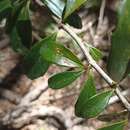en
names in breadcrumbs


Berberis valdiviana is a species of flowering plant in the barberry family Berberidaceae. It is an evergreen shrub from Chile, where it is locally known as cien or espina en cruz. The Latin specific name valdiviana refers to the Valdivia Province of Chile.[2] It has simple, dark green, pointed leaves, glossy on the upper surfaces, up to 8.5 cm (3.3 in) long. The flowers, which appear in May, are grouped in hanging racemes. Individual flowers are orange, 5–8 mm (0.2–0.3 in) across, and are followed by purplish fruits. It is grown as an ornamental plant, but is not suitable for colder regions.[3]
In cultivation in the UK, where it eventually reaches a size of 4 metres (13 ft) tall and broad, this plant has gained the Royal Horticultural Society’s Award of Garden Merit.[4] It is hardy in the UK down to −15 °C (5 °F).
Berberis valdiviana is a species of flowering plant in the barberry family Berberidaceae. It is an evergreen shrub from Chile, where it is locally known as cien or espina en cruz. The Latin specific name valdiviana refers to the Valdivia Province of Chile. It has simple, dark green, pointed leaves, glossy on the upper surfaces, up to 8.5 cm (3.3 in) long. The flowers, which appear in May, are grouped in hanging racemes. Individual flowers are orange, 5–8 mm (0.2–0.3 in) across, and are followed by purplish fruits. It is grown as an ornamental plant, but is not suitable for colder regions.
In cultivation in the UK, where it eventually reaches a size of 4 metres (13 ft) tall and broad, this plant has gained the Royal Horticultural Society’s Award of Garden Merit. It is hardy in the UK down to −15 °C (5 °F).